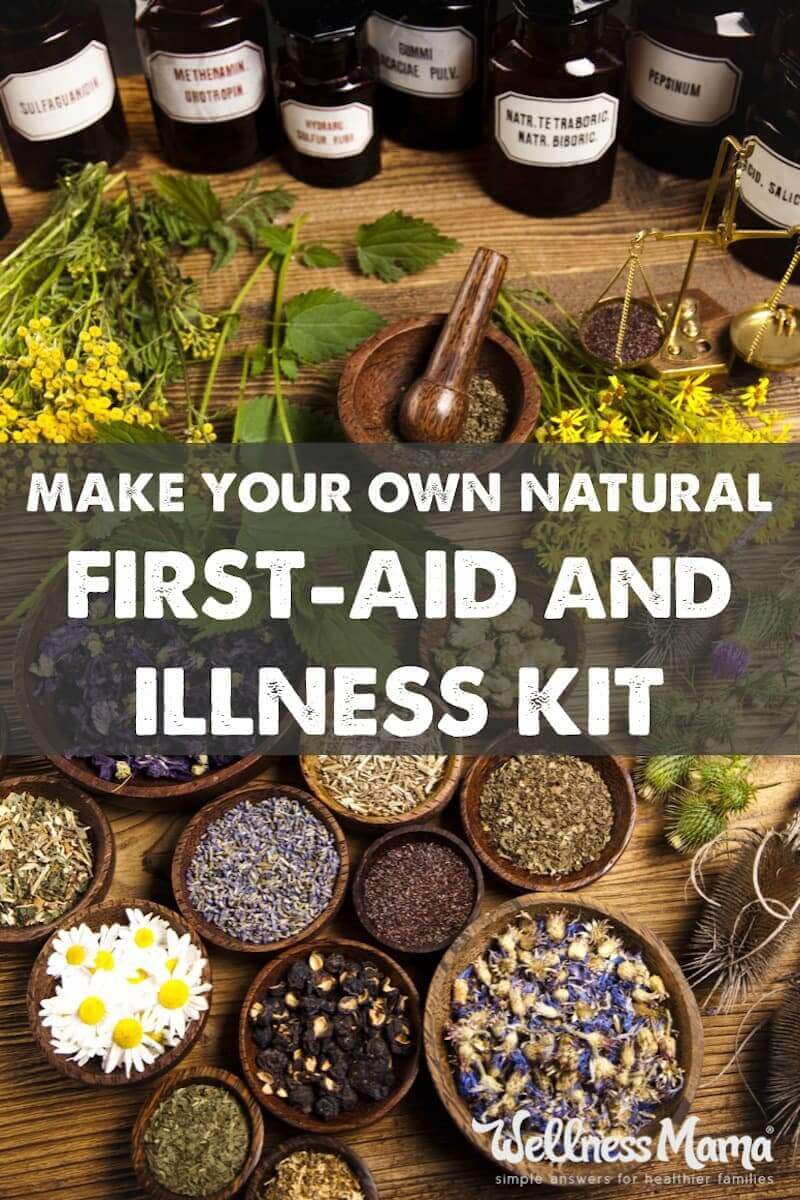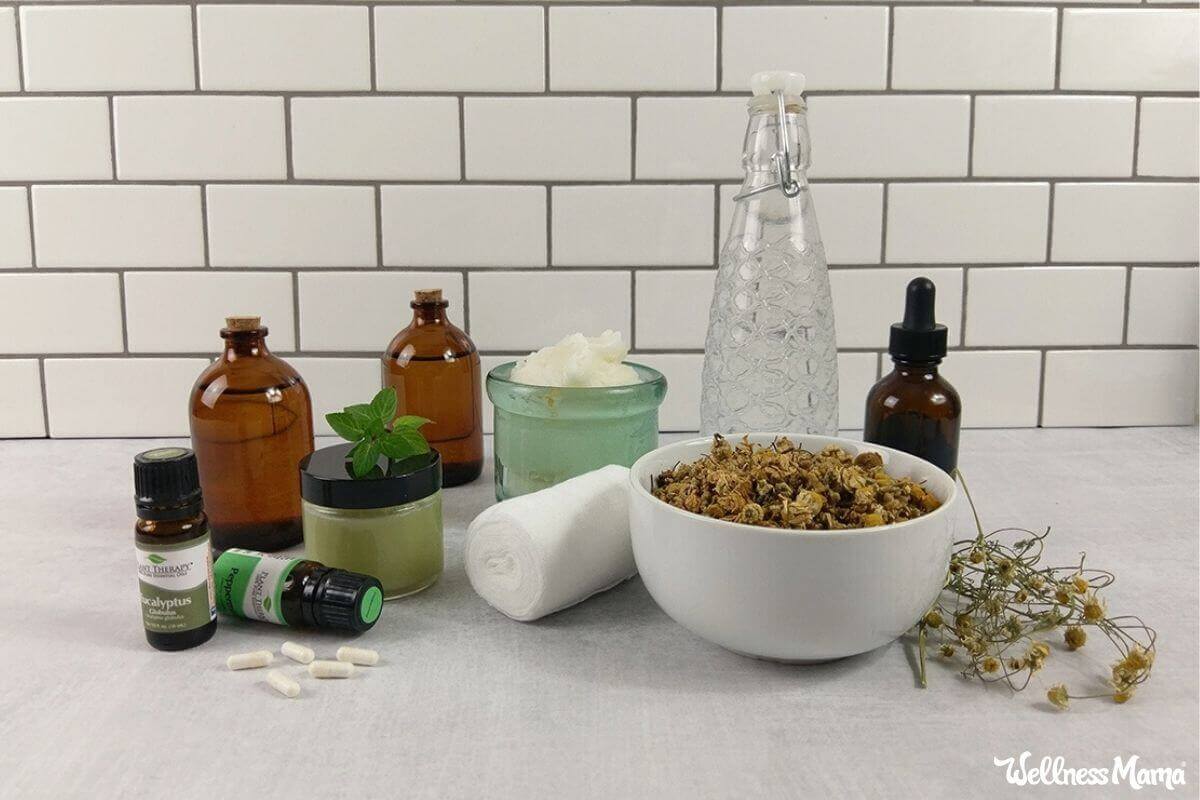Despite our best attempts to live a healthy and toxin free life, there are times when illness or injury strikes. In some of these cases (like trauma) conventional medical treatment is certainly warranted, and I’m certainly grateful that medical treatment is available if needed.
But what about the times when the illness or injury is not life-threatening, but merely uncomfortable or limiting?
The following is a list of what you’ll find in my “medicine” cabinet and natural first aid kit. It is a combination of remedies I’ve tested myself, ones suggested by a naturopathic doctor, and ones that I hope to never need!
Please note that I am not a doctor and don’t play one on the Internet, so this list is for informational purposes only and is not intended to be used as a replacement for medical attention.
Remedies & Herbs in My Natural First Aid Kit
Before we start, keep in mind that I didn’t build up this list overnight! It took many years of research and trial and error to find the remedies I use and trust the most.
Activated Charcoal- For acute use in food poisoning, intestinal illness, vomiting, diarrhea, ingestion of toxins, etc. Also, keep the local poison control number on hand in case a child ingests a toxic substance and immediately take a child to the hospital if he/she has swallowed a battery or magnet!
Arnica– Topical creme used for muscle pain or injury, bruises, or any type of trauma. We’ve found that it greatly reduced healing time or bruises and sore muscles when used topically right after an injury. Not for internal use or use on open cuts.
Homeopathics – Along with arnica (above), I keep a stash of Genexa homeopathic tablets on hand for helping kids with sleep, cold relief, and even anxiety.
Cayenne Powder– Though this is a good addition to many foods, it’s even better to have in a medicine cabinet. I keep a few cayenne capsules in my purse as well. Topically, cayenne powder helps stop bleeding rapidly. I’ve read cases of it being taken internally during heart attacks to increase blood flow and help clear blockage, though thankfully, I’ve never had to test this one. It is also a useful remedy to take internally during illness as it is shown to increase blood flow and speed recovery (although I do not give it to children).
Chamomile– I use it to make a relaxing tincture that helps calm kids if they are ill or just have trouble sleeping. The tincture also works wonders on teething gums. The dried flowers can also be made into a poultice with some gauze and placed on an eye for 15 minutes every hour to help relieve pink eye (usually works in a couple of hours). Brewed as a tea, chamomile is a relaxing drink at night and the tea can be cooled and rubbed on the stomach of colicky infants to help soothe them. I sometimes add some brewed chamomile tea to the kid’s bath as it is great for the skin and promotes relaxation. I keep the tincture in my purse at all times.
Comfrey– An external herb that promotes healing from injuries and broken bones. A poultice made with plantain and comfrey that is placed on a wound can greatly reduce the healing time and help prevent and reverse infection. I make a homemade “Neosporin” with this and other herbs and use it on bug bites, cuts, bruises, and poison ivy. It is best to keep the dried herb on hand for poultices and homemade salves.
Eucalyptus Herb and Essential Oils– I keep these in my natural first aid kit for respiratory type problems. We use eucalyptus herb in a face steam for congestion or sinus troubles and I make a mild (and petroleum-free) version of Vapo-Rub for coughing and respiratory illness. The essential oil can be diluted with coconut oil or olive oil and be applied externally to the feet and chest to help open nasal passageways.
Ginger Capsules– Ginger is great for nausea, reflux, stomach trouble, and morning sickness. I also keep some in the car for motion sickness. It helps soothe the stomach after a digestive illness or food poisoning.
Echinacea– I keep a homemade echinacea tincture on hand for severe illnesses. I don’t use it as a first resort, but it is helpful in prolonged illnesses.
Peppermint Herb and Essential Oil– Another great digestive herb. For upset stomach or digestive illness, the herb is made into tea. The tincture can be used internally or externally for headaches. When combined with a few other digestive herbs, it makes a highly effective digestive aid and nausea remedy. We also use this essential oil in our homemade toothpaste.
Plantain– You’ve probably pulled this as a weed without knowing it! I keep the dried herb on hand at all times to make into a poultice for poison ivy, bites, stings, cuts, and infection. In a pinch, I’ve picked some from the ground, chewed it, and put it on a bee sting for immediate pain relief.
Slippery Elm– Helpful for sore or irritated throat or when you lose your voice. These lozenges taste great and are helpful for kids with sore throats. The herb itself can be used in tinctures or teas for sore throat relief.
Apple Cider Vinegar– I keep a bottle of organic Apple Cider Vinegar with “the mother” on hand for digestive troubles, indigestion, food poisoning, and more. Taken in a dose of 1 teaspoon per 8 ounces of water every hour, it helps shorten the duration of any type of illness, though it is tough to get kids to take it willingly.
Vitamin C– Helpful for all illnesses, but especially flu-related illnesses. I keep the powder on hand because it is additive-free and can be mixed into food or drinks to get the kids to consume it.
Aloe Vera Plant– We have one growing in the house for burns and blisters.
Epsom Salt– Good as a bath soak for sore muscles. Dissolved in water, it can also be a good soak to help remove splinters.
Hydrogen Peroxide– I keep several bottles on hand at all times. It’s perfect for disinfecting, cleaning small cuts, and in my homemade OxyClean. Personally, I also use a dropper full of hydrogen peroxide in the ear at the first sign of ear infection (but check with your doctor first). I leave the peroxide in for 15 minutes or until it stops bubbling and then repeat on the other side.
Homemade Neosporin– I make my own “boo-boo” lotion as my kids call it (no petroleum needed). I keep it in small tins and in lip chap containers for on-the-go size. I use this on cuts, bruises, rashes, and anything else antibiotic ointment could be used on.
Witch Hazel– I keep a gallon on hand for use on cuts, scrapes, and cosmetic uses. It makes a great skin toner and is good for the postpartum bottom. 🙂
Gelatin– I take gelatin regularly for its health benefits, but I also keep it on hand for first aid and illness. The natural gelatin in homemade chicken soup (from the bones and tissue) is one of the things that makes it so nourishing during illness. During any type of illness, the afflicted gets gelatin in various ways: in food, homemade jello, smoothies, and hot tea.
Baking Soda– Also a good remedy to keep on hand. For severe heartburn or urinary tract infections, 1/4 tsp can be taken internally to help alleviate quickly. It can also be made into a poultice and used on sider bites.
Probiotics– These are the probiotics we use during any illness and afterward to repair gut bacteria. I’ve seen clients improve skin conditions with regular use of probiotics, and I especially recommend them to pregnant mothers, as newborn babies receive their gut bacteria from their mothers. For children who get constant illness and ear infections, probiotics can also really help.
Coconut Oil– From skin salve to diaper creme, makeup remover, and even antifungal treatment, coconut oil is great to have around! I keep some in the natural first aid kit to add remedies to take internally, use in tinctures, and apply externally to dry skin and chapped lips.
A Better-for-You Medicine Cabinet
The only actual medicines you’ll find in my cabinet comes from Genexa and their line of no dye, no preservative, additive-free medicines. They have everything from pain reliever to saline, as well as homeopathic medicines. You may also be able to find these in a local pharmacy near you!
Other Natural First Aid Kit Supplies
- Patch Bandages- These bandages are made from 100% organic bamboo and are enriched with coconut oil.
- Butterfly Bandages
- Gauze
- Superglue– On minor to moderate skin cuts (not puncture wounds) use superglue and butterfly bandages. I’ve used this instead of stitches several times and it healed faster and left less scarring than the places I’ve had stitches. This especially works for the face and other visible areas that scar easily or in the hair where other bandages can be difficult to apply. I’ve also used it on fingertips or knuckles (I’m infamous for grating knuckles while cooking) or other places where band-aids won’t stay well.
- Strips of sterilized muslin cloth in plastic bags for wrapping wounds.
- Cut off wool sleeves from old sweaters to cover bandages and hold ice packs
- Hot water bottle
- Enema kit
- Bulb syringe and NoseFrida for helping with congestion in children
- Homemade ice pack (just freeze liquid dish soap or rubbing alcohol in a double-bagged- ziplock bag and use as an ice pack.
Learn how to store and organize your natural remedies here.
This article was medically reviewed by Madiha Saeed, MD, a board certified family physician. As always, this is not personal medical advice and we recommend that you talk with your doctor.
Do you use any natural remedies for illness or first aid? Share your tips below!



Leave a Reply